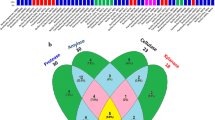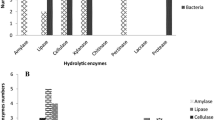Abstract
Microbes colonizing high elevation hot springs have been extensively studied in last decades. In this sense, Armenian highland geothermal springs are in the center of attention for exploring new thermophilic microbes with biotechnological prospects. In present paper, the identification and characterization of two thermoactinomycetes isolated from Armenian geothermal springs, namely Akhurik and Tatev, were reported. The isolates, designated as AkhA-12 and Tatev 35a were studied for phenotypic and phylogenetic profiling. The aerial and substrate mycelia formed by strain AkhA-12 were yellow-white and greyish-yellow respectively. The strain Tatev 35a developed white aerial and substrate mycelia. The endospores produced by thermoactinomycetes were round in shape (0.7–0.9 µm in diameter) and located on short unbranched sporophores. The strains grew aerobically at 35–60 °C (Topt 50–55 °C). The pH range for growth was observed between 5.0 and 8.0 with optimum pH 7.0–7.4. Both strains were able to grow at 0–8% NaCl (optimum 2–3%). Based on phenotypic characteristics and phylogenetic analyses (16S rRNA gene sequence analysis) both strains were identified as representatives of the genus Thermoactinomyces. The strain AkhA-12 demonstrated close relationship to Thermoactinomyces sp. JIR-004 (99.7% similarity) and T. daqus DSM 45914T (99.4% similarity), while the strain Tatev 35a was closely related to T. vulgaris DSM 43016T (99.01%). The ability to synthesize extracellular hydrolases (amylase, lipase and protease) was evaluated by growth of strains on solid media supplemented with appropriate substrate at different temperatures. The active production of thermostable hydrolytic enzymes by strains indicates their potential in biotechnology.


Similar content being viewed by others
References
Aksoy SÇ, Uzel A, Hameş Kocabaş EE (2012) Extracellular serine proteases produced by Thermoactinomyces strains from hot springs and soils of West Anatolia. Ann Microbiol 62:483–492
Altschul SF, Madden TL, Schaffer AA, Zhang J, Miller W, Lipman DJ (1997) Gapped BLAST and PSI-BLAST: a new generation of protein database search programs. Nucleic Acids Res 25:3389–3402
Carrillo L, Benıtez-Ahrendts MR (2014) The Family Thermoactinomycetaceae. In: Rosenberg E et al (eds) The prokaryotes—firmicutes and tenericutes. Springer-Verlag, Heidelberg, pp 389–411
Charliera D, Droogmansb L (2005) Microbial life at high temperature, the challenges, the strategies. Cell Mol Life Sci 62:2974–2984
Chaudhary N, Prabhu S (2016) Thermophilic actinomycetes from hot water spring capable of producing enzymes of industrial importance. Int J Res Stud Biosci (IJRSB) 4(6):29–35. https://doi.org/10.20431/2349-0365.0406005
DeCastro ME, Rodríguez-Belmonte E, González-Siso MI (2016) Metagenomics of thermophiles with a focus on discovery of novel thermozymes. Front Microbiol 7:1521. https://doi.org/10.3389/fmicb.2016.01521
Derekova A, Mandeva R, Kambourova M (2008) Phylogenetic diversity of thermophilic carbohydrate degrading bacilli from Bulgarian hot springs. World J Microbiol Biotechnol 24:1697–1702
Felsenstein J (1985) Confidence limits on phylogenies: an approach using the bootstrap. Evolution 39:783–791
Goodfellow M, Jones AL (2009) Family IX. Thermoactinomycetaceae Matsuo, Katsuta, Matsuda, Shizuri, Yokota and Kasai 2006, 2840VP. In: Bergey’s manual of systematic bacteriology, 2nd edn. V 3 The Firmicutes, Springer, Dordrecht, Heidelberg, London, New York, pp 434–453
Han H, Ling Z, Khan A, Virk AK, Kulshrestha S, Li X (2019) Improvements of thermophilic enzymes: from genetic modifications to applications. Bioresour Technol 279:350–361. https://doi.org/10.1016/j.biortech.2019.01.087
Henneberger R, Cooksley D, Hallberg J (2000) Geothermal resources of Armenia. Proceedings World Geothermal Congress. Kyushu-Tohoku, Japan, pp 1217–1222
Jadoon MA, Ahmad T, Rehman MMU, Khan A, Majid A (2014) Isolation and identification of thermophillic actinomycetes from hot water springs from Azad Jammu and Kashmir Pakistan for the production of thermophilic amylase. World Appl Sci J (WASJ) 30(3):350–354. https://doi.org/10.5829/idosi.wasj.2014.30.03.82338
Kambourova M (2018) Thermostable enzymes and polysaccharidesproduced by thermophilic bacteria isolated from Bulgarian hot springs. Eng Life Sci 18:758–767
Kumar S, Stecher G, Li M, Knyaz C, Tamura K (2018) MEGA X: molecular evolutionary genetics analysis across computing platforms. Mol Biol Evol 35:1547–1549
Mehta D, Satyanarayana T (2013) Diversity of hot environments and thermophilic microbes. In: Satyanarayana T et al (eds) Thermophilic microbes in environmental and industrial biotechnology: biotechnology of thermophiles. Springer, Dordrecht, pp 3–60
Mkrtchyan S (ed) (1969) Geology of armenian SSR. Publishing house of AS of ASSR, Yerevan (in Russian)
Mokrane S, Bouras N, Meklat A, Lahoum A, Zitouni A, Verheecke C, Mathieu F, Schumann P, Spröer C, Sabaou N, Klenk HP (2016) Thermoactinomyces khenchelensis sp. nov., a filamentous bacterium isolated from soil sediment of a terrestrial hot spring. Antonie Van Leeuwenhoek 109(2):311–317
Nishiyama M, Yamamoto S, Kurosawa N (2013) Microbial community analysis of a coastal hot spring in Kagoshima, Japan, using molecular- and culture-based approaches. J Microbiol 51(4):413–422
Panosyan HH (2017) Thermophilic bacilli isolated from Armenian geothermal springs and their potential for production of hydrolytic enzymes. Int J Biotech Bioeng 3(8):239–244. https://doi.org/10.25141/2475-3432-2017-7.0239
Panosyan H, Birkeland NK (2014) Microbial diversity in an Armenian geothermal spring assessed by molecular and culture-based methods. J Basic Microbiol 54(11):1240–1250
Panosyan H, Margaryan A, Poghosyan L, Saghatelyan A, Gabashvili E, Jaiani E, Birkeland NK (2018) Microbial diversity of terrestrial geothermal springs in Lesser Caucasus. In: Egamberdieva D et al (eds) Extremophiles in eurasian ecosystems: ecology, diversity, and applications. Springer, Singapore, pp 81–117
Raddadi N, Cherif A, Daffonchio D, Neifar M, Fava F (2015) Biotechnological applications of extremophiles, extremozymes and extremolytes. Appl Microbiol Biotechnol 99(19):7907–7913
Rozanov AS, Bryanskaya AV, Kotenko AV, Peltek SE (2017) Draft genome sequence of Thermoactinomyces sp. Gus2-1 isolated from the hot-spring Gusikha in Bargusin Valley (Baikal Rift Zone, Russia). Genomics Data 11:1–2
Sahay H, Yadav AN, Singh AK, Singh S, Kaushik R, Saxena AK (2017) Hot springs of Indian Himalayas: Potential sources of microbial diversity and thermostable hydrolytic enzymes. 3 Biotech 7:118. https://doi.org/10.1007/s13205-017-0762-1
Shahinyan G, Margaryan AA, Panosyan HH, Trchounian AH (2017) Identification and sequence analysis of novel lipase encoding novel thermophilic bacilli isolated from Armenian geothermal springs. BMC Microbiol 17:103. https://doi.org/10.1186/s12866-017-1016-4
Tamura K, Nei M, Kumar S (2004) Prospects for inferring very large phylogenies by using the neighbor-joining method. Proc Natl Acad Sci (USA) 101:11030–11035
Tindall BJ, Sikorski J, Smibert RA, Krieg NR (2007) Phenotypic characterization and the principles of comparative systematics. In: Reddy CA et al (eds) Methods for general and molecular microbiology, 3rd edn. American Society of Microbiology, Washington, DC, pp 330–393
Uzel A, Hameş Kocabaş EE, Bedir E (2011) Prevalence of Thermoactinomyces thalpophilus and T. sacchari strains with biotechnological potential at hot springs and soils from West Anatolia in Turkey. Turk J Biol 35:195–202. https://doi.org/10.3906/biy-0907-72
Verma A, Singh H, Anwar MS, Kumar S, Ansari MW, Agrawal S (2016) Production of thermostable organic solvent tolerant keratinolytic protease from Thermoactinomyces sp. RM4: IAA production and plant growth promotion. Front Microbiol 7:1189. https://doi.org/10.3389/fmicb.2016.01189
Waithaka PN, Mwaura FB, Wagacha JM, Gathuru EM (2017) Isolation of actinomycetes from geothermal vents of Menengai crater in Kenya. Int J Mol Biol Open Access 2(5):132–139
Williams ST, Goodfellow M, Alderson G, Wellington EMH, Sneath PHA, Sackin MJ (1983) Numerical classification of Streptomyces and related genera. J Gen Microbiol 129:1743–1813
Wu H, Liu B, Pan S (2015) Thermoactinomyces guangxiensis sp. nov., a thermophilic actinomycetes isolated from mushroom compost. Int J Syst Evol Microbiol 65:2859–2864
Yadav P, Korpole S, Prasad GS, Sahni G, Maharjan J, Sreerama L, Bhattarai T (2018) Morphological, enzymatic screening, and phylogenetic analysis of thermophilic bacilli isolated from five hot springs of Myagdi, Nepal. J App Biol Biotech 6(3):1–8. https://doi.org/10.7324/JABB.2018.60301
Yao S, Liu Y, Zhang M, Zhang X, Li H, Zhao T, Xin C, Xu L, Zhang B, Cheng C (2014) Thermoactinomyces daqus sp. nov., a thermophilic bacterium isolated from high-temperature Daqu. Int J Syst Evol Microbiol 64:206–210
Yoon J-H, Kim I-G, Shin Y-K, Park Y-H (2005) Proposal of the genus Thermoactinomyces sensu stricto and three new genera, Laceyella, Thermoflavimicrobium and Seinonella, on the basis of phenotypic, phylogenetic and chemotaxonomic analyses. Int J Syst Evol Microbiol 55:395–400
Acknowledgements
This work was supported by the RA MES State Committee of Science, in the frames of the research projects no 15T-1F399 and no 18T-1F261, Armenian National Science and Education Fund based in New York, USA, to HP ANSEF-NS-microbio 4676 Grants.
Author information
Authors and Affiliations
Corresponding author
Additional information
Publisher's Note
Springer Nature remains neutral with regard to jurisdictional claims in published maps and institutional affiliations.
Rights and permissions
About this article
Cite this article
Panosyan, H. Thermoactinomycetes isolated from geothermal springs in Armenia capable of producing extracellular hydrolases. Environmental Sustainability 2, 219–226 (2019). https://doi.org/10.1007/s42398-019-00066-0
Received:
Revised:
Accepted:
Published:
Issue Date:
DOI: https://doi.org/10.1007/s42398-019-00066-0




